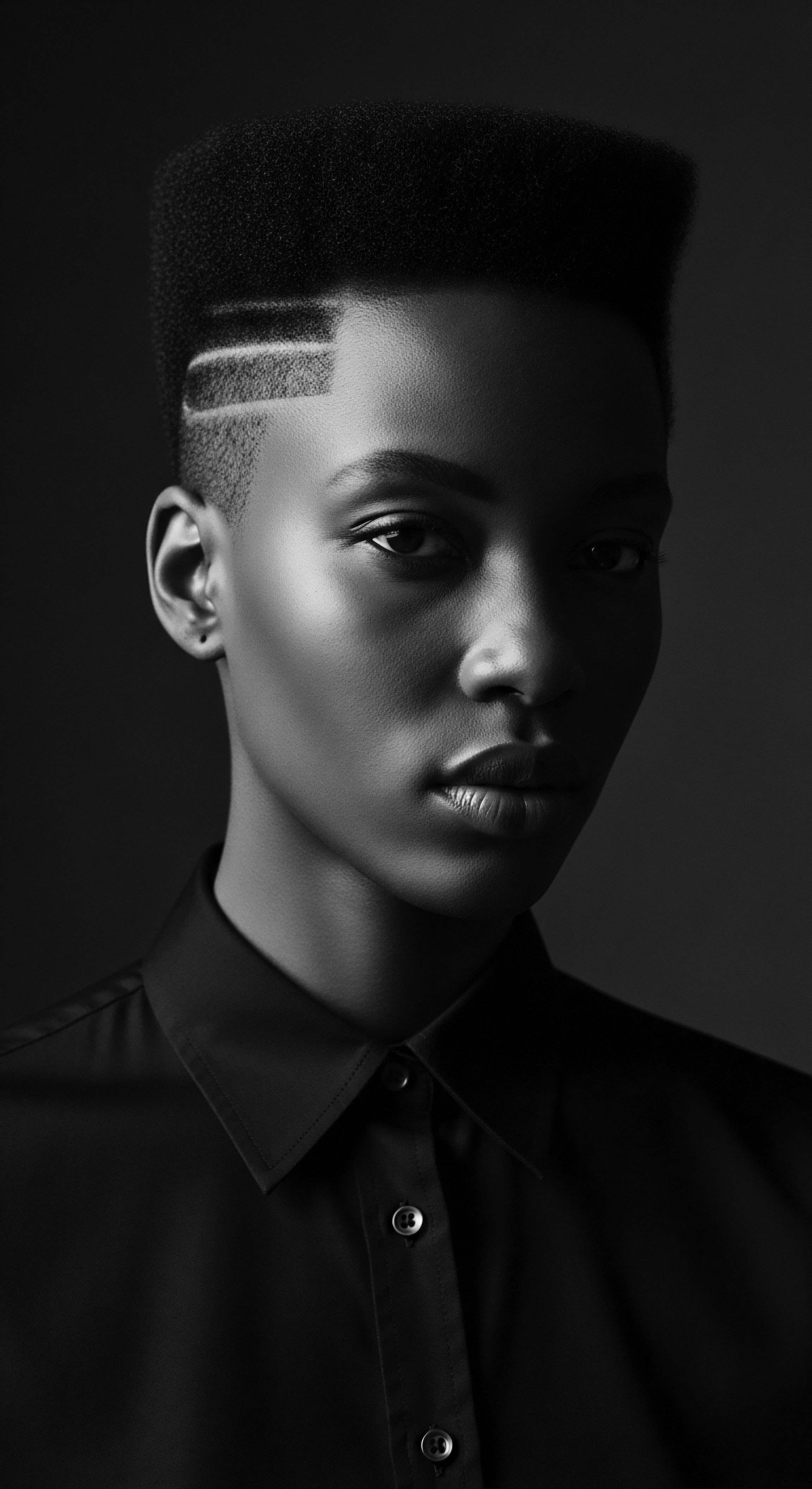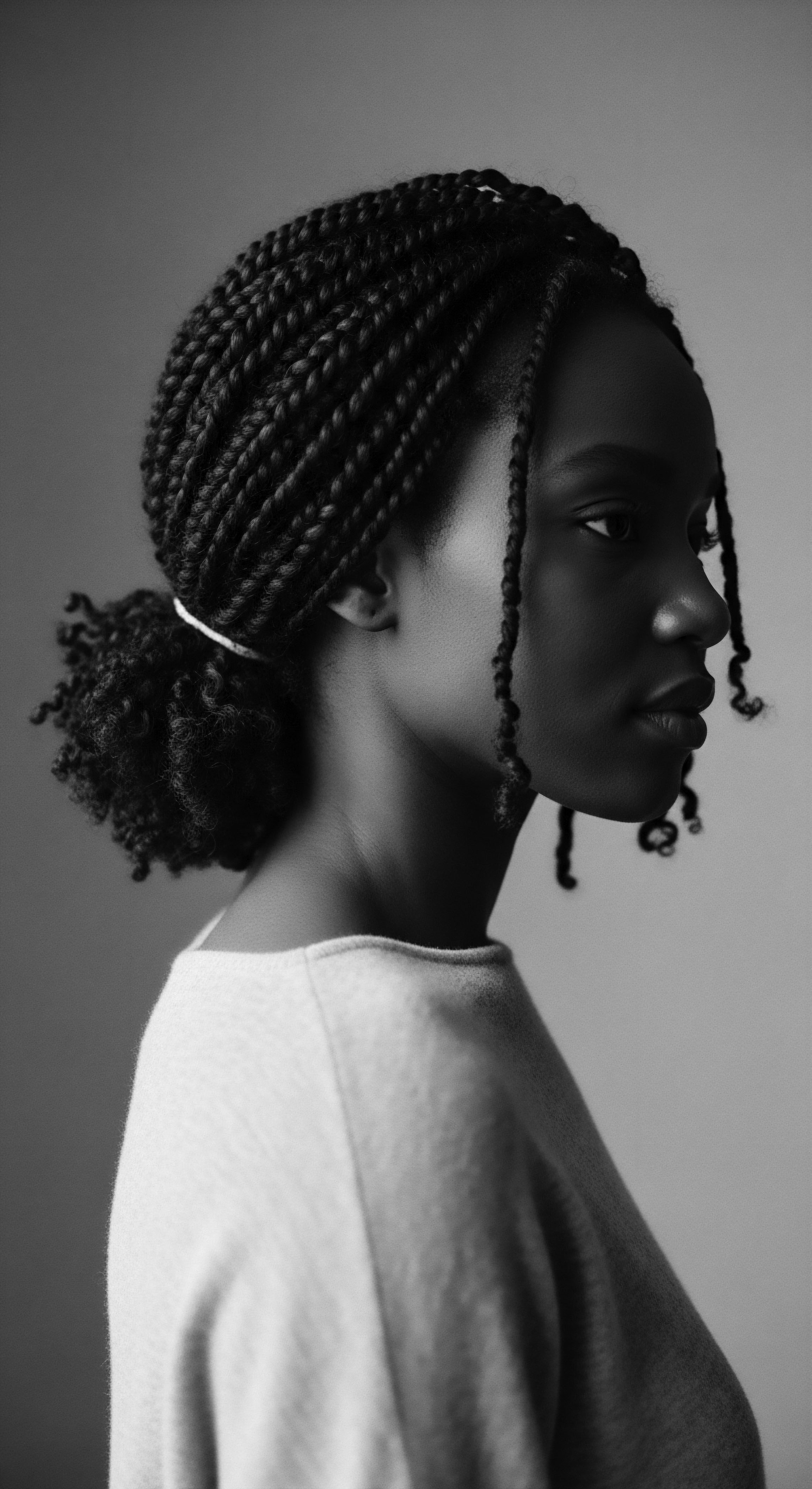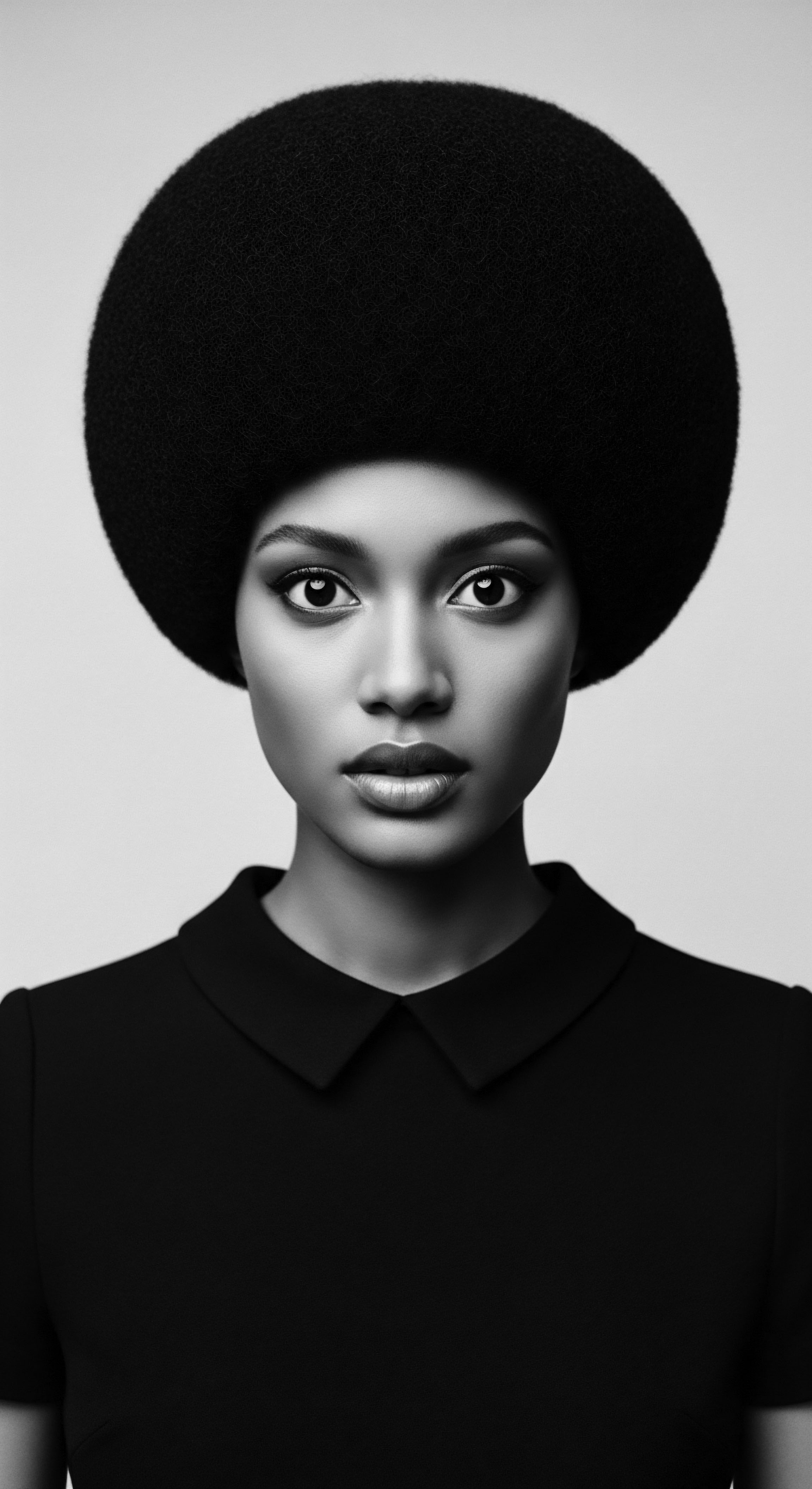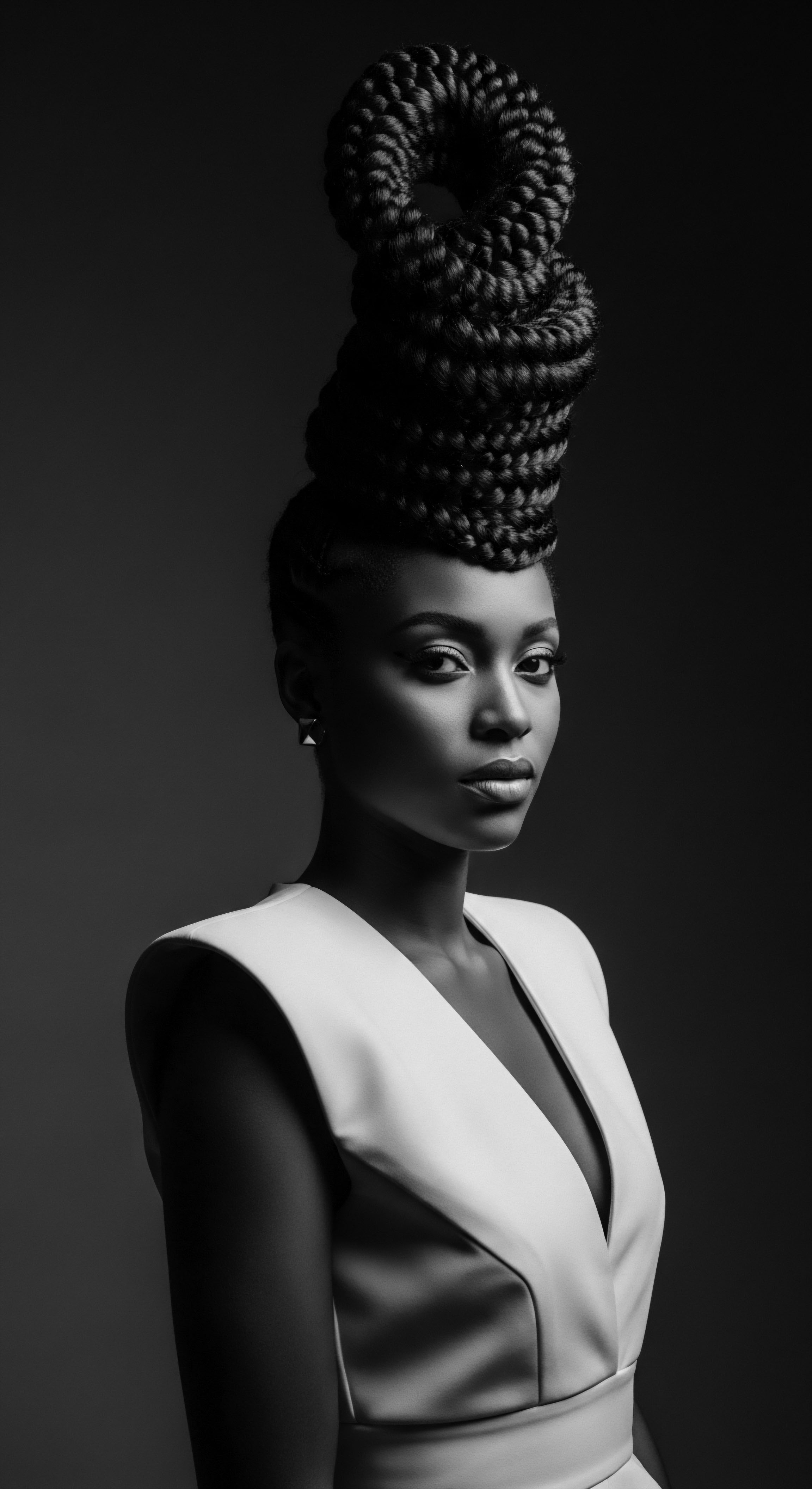
Fundamentals
The concept of Aztec Hair Symbolism speaks to a rich tapestry of meaning, extending far beyond mere aesthetic preference within ancient Mesoamerican societies. It was, at its heart, a profound declaration of identity, status, and spiritual connection. For the Mexica people, the dominant culture within the broader Aztec Empire, hair was understood not merely as a physical attribute but as a vibrant extension of the self, deeply intertwined with the very essence of one’s being, the life force known as Tonalli . This spiritual power, believed to reside primarily in the head and its crown of hair, rendered each strand sacred, a conduit for strength and spiritual vitality.
The way a person wore their hair offered a direct visual lexicon, immediately conveying their place within the intricate social hierarchies of the empire. From the youngest children to the most venerated priests and formidable warriors, hairstyles served as markers of age, marital standing, tribal affiliation, and professional accomplishment. This nuanced system meant that a glance at an individual’s coiffure could reveal their life’s journey, their current responsibilities, and even their aspirations within their community. Such understanding highlights a society where every external presentation carried a layered, communal significance.
The communal ethos found in Mesoamerican traditions, where the self is intrinsically linked to the collective, shines through in the way hair was revered and styled. It mirrored the deeper societal structure, reinforcing bonds and recognizing individual roles within the larger framework. This understanding lays a foundational stone for appreciating the profound cultural significance of hair within textured hair heritage, where communal practices and identity markers often converge in deeply personal and collective expressions.
Aztec Hair Symbolism represents a complex cultural language, where hair communicated an individual’s identity, status, and spiritual connection to the life force known as tonalli .

Social Fabric and Hair’s Expression
Within the Aztec world, hair offered a clear illustration of social stratification, a visual shorthand for one’s position. Consider the earliest stages of life ❉ young male children typically kept their heads shaved until around the age of ten, a communal practice marking their initial developmental phase. Upon reaching this symbolic threshold, they were permitted to cultivate a patch of hair at the back of their heads, signaling their transition into a new stage of life, one of greater responsibility and nascent identity formation. This custom instilled from a young age a recognition of hair as a dynamic aspect of self, evolving with life’s passages.
- Children’s Hair Growth ❉ Signified a transition from early childhood to a stage of growing awareness and preparation for community roles.
- Commoner Styles ❉ Generally adhered to simpler, shorter styles, reinforcing their practical roles in daily life.
- Warrior Hairstyles ❉ Were visual resumes of battlefield achievements, with each captured foe often translating to a specific, prestigious coiffure.
- Priestly Locks ❉ The deliberate, untended length of a priest’s hair spoke volumes of their devotion and detachment from worldly vanities.
This intricate system of hair expression provides a compelling parallel to the ways textured hair across the Black and mixed-race diaspora has historically served as a canvas for identity, resistance, and communal belonging. Just as Aztec hairstyles communicated tribal origins and social standing, so too have cornrows, braids, and locs in various African and diasporic cultures acted as profound statements of heritage, spirituality, and resilience.

Intermediate
Moving beyond the foundational understanding, the intermediate layers of Aztec Hair Symbolism unveil the nuanced interplay between personal adornment and spiritual adherence. Hair was a living narrative, its form and adornment charting a person’s spiritual journey and their embeddedness within the cosmic order. The sacredness of hair was not merely an abstract concept; it was a practical reality that influenced daily care rituals, ceremonial preparations, and even the consequences for those who transgressed societal norms.

The Living Narrative of Hairstyles
For the Mexica, hair possessed a dynamism reflecting life’s continuous flow. A warrior’s hair, for instance, became a testament to his martial prowess. The Florentine Codex describes how after a warrior captured four enemies in battle, his hair would be cut in a manner that publicly affirmed his elevated status as a Seasoned Warrior. This ceremonial act transformed his physical appearance into a living trophy, imbued with the tonalli of his defeated adversaries.
Such a visible marker of achievement was a powerful motivator within a society that valued military success. The significance of this particular detail provides an intriguing insight into the Aztec worldview ❉ a warrior’s very being, his spirit and social standing, could be enhanced through the ritualistic control of hair, directly linked to his exploits on the battlefield.
Women’s hair, while often styled with intricate braids and adorned with colorful ribbons, flowers, or beads, conveyed distinct messages about their marital status and familial connections. A hairstyle known as Neaxtlāwalli , where hair was twisted with black cord and wound about the head, was often used to signify a woman’s married state. These practices underscore the importance of hair as a visual language within the community, providing information about an individual’s personal life while simultaneously linking them to broader societal expectations and roles.
Hair in Aztec society served as a dynamic visual language, meticulously crafted styles and adornments communicating profound insights into an individual’s status, achievements, and life circumstances.

Rituals of Care and Consequence
Care for hair extended beyond mere cleanliness; it was an act of reverence for the tonalli it housed. Ancient Aztec women utilized natural ingredients for hair care, drawing directly from the earth’s bounty. Avocado stone oil, for example, served as a conditioning agent for lustrous locks, while Axin , a greasy yellow substance derived from pulverized insects, was applied for both color and shine.
Indigo, a natural dye, imparted a deep, radiant sheen to hair, and black mud was also used for coloring. These practices mirror the ancestral wisdom found in many textured hair traditions, where indigenous plant-based remedies and natural resources form the foundation of hair nourishment and beautification.
The deliberate choice to allow a priest’s hair to grow long and untended, often becoming matted with soot and tied with simple white ribbons, signified their profound humility and singular devotion to spiritual duties. Conversely, the cutting of a priest’s hair above their forehead served as a severe punishment for failing in their sacred duties, a symbolic severing of their spiritual authority and connection to the divine. This practice demonstrates a societal recognition that the spiritual power embodied in hair could be both cultivated and revoked, mirroring the deep respect accorded to it.
Hair was not only a symbol of life but also held a significant role in Aztec mourning rituals. The practice of preserving the first hair grown at birth and placing it with the last hair cut after death in the urn containing a person’s ashes speaks to a belief in reuniting the body and spirit. This profound act suggests that the physical strands carried an enduring spiritual resonance, tying an individual’s earthly journey to their passage into the afterlife. The custom of ritual weeping also involved hair, underscoring its essential presence in ceremonies of grief and remembrance.

Academic
The academic exploration of Aztec Hair Symbolism requires an examination of its structural role within the Mexica cosmos, delving into how hair functioned as a primary medium for expressing ontological, social, and ritualistic truths. The interpretation of hair is inextricably linked to the concept of Tonalli , a vital animistic force integral to ancient Nahua philosophy. Located primarily within the fontanel area of the skull and extending into the hair, tonalli conferred vigor, energy, and developmental impetus. It was not merely a physical attribute; it was a fundamental component of the soul, a receptacle of spiritual power that anchored an individual’s life force to their corporeal form.
The materiality of hair, its growth, texture, and adornment, provided a tangible interface for the manifestation of abstract spiritual concepts. This is evidenced in the Nahuatl word for hair, Tzontli , which also signified the numerical value of 400. This dual meaning conveys a sense of abundance, a quantity as bountiful as the strands upon one’s head, metaphorically connecting the individual’s physical being to vastness and plenitude. The symbolic significance of this linguistic linkage underscores the Aztec capacity for layered meaning, where a single term could simultaneously denote a physical entity and a profound numerical or existential concept.
The regulation of hair, therefore, extended into nearly every sphere of Aztec life, from military ranks to religious devotion and even the administration of justice. Codex Mendoza and the Florentine Codex, foundational historical documents, meticulously illustrate the specific hairstyles assigned to different societal roles, revealing a society where visual cues were paramount in maintaining social order and communicating identity. This systematic codification of hair practices reveals a highly sophisticated understanding of semiotics, where physical presentation served as a legible text for communal understanding.

The Tonalli and Its Corporeal Manifestation
The spiritual weight attached to tonalli meant that the manipulation or loss of hair carried profound consequences. In warfare, grasping a captive by their hair, particularly the tuft near the fontanel, was not simply an act of physical subjugation; it was a symbolic act of seizing their tonalli. This practice was believed to transfer the valor and life force of the defeated warrior to the captor, augmenting his own spiritual strength and reputation.
Indeed, the Mexica warriors would often sever and retain this tuft of hair as a war trophy, akin to the pan-American practice of scalping, thereby physically retaining the tonalli as a testament to their prowess. This ritualized acquisition of spiritual power through hair demonstrates a complex belief system where the body was not merely a vessel but a dynamic site of energetic exchange.
The punishment for certain delinquencies also involved the cutting of hair, particularly for misbehaving schoolchildren or errant priests. This sanction was a powerful visual declaration of disgrace, severing the individual’s spiritual protection and exposing them to perceived harm. López Austin (1988), in his work on ancient Nahua concepts, notes that hair formed a protective covering over the head, preventing the tonalli ‘s departure, and consequently, damaging it inflicted harm upon the person. Such punitive measures highlight the deep cultural reverence for hair, understanding its alteration as a form of spiritual and social incapacitation.
The Aztec understanding of hair as a receptacle of tonalli aligns with broader Indigenous cosmological views across the Americas, where hair is often regarded as sacred, holding knowledge, wisdom, and a connection to ancestral spirits and the earth. For many Native peoples, hair is a physical extension of their Ní —or spirit—and is carefully maintained, with particular beliefs surrounding who may touch it and when it may be cut.
This cultural understanding of hair’s spiritual significance was tragically exploited during periods of colonization, not only in Mesoamerica but also in the later experiences of Indigenous and Black communities. For example, during the forced assimilation of Indigenous children in Canadian and American residential schools, a deliberate act of cultural violence involved forcibly cutting their long hair upon arrival. This act, intended to sever their connection to their heritage and spiritual identity, mirrors the Aztec punishment of cutting a priest’s hair, underscoring a universal colonial strategy of dehumanization through the control of indigenous hair practices.
The profound spiritual and social significance of Aztec hair, rooted in the concept of tonalli, finds powerful echoes in the broader history of textured hair as a symbol of identity, resilience, and resistance against colonial assimilation.

Hair as Resistance ❉ A Trans-Historical Perspective
The deliberate control of hair became a tool of oppression, yet simultaneously, maintaining traditional hairstyles emerged as a potent symbol of resistance and cultural survival for marginalized communities. While direct examples of Aztec resistance through hair post-conquest are scarce due to the comprehensive nature of the Spanish invasion and the destruction of indigenous records, the underlying symbolic framework of hair as tonalli provides a crucial lens through which to understand later acts of resistance. The sheer importance of hair in pre-Columbian society implies that its forced alteration would have been perceived as a profound spiritual injury, a direct assault on the very essence of personhood.
One powerful modern case study that illuminates this enduring connection between hair and resistance, resonating deeply with the principles of Aztec Hair Symbolism, comes from the experiences of Indigenous Men in North America. Michael Linklater, a Nehiyaw (Cree) man from Thunderchild First Nation, founded the “Boys with Braids” collective. This initiative celebrates Indigenous boys and men who wear long hair, actively pushing back against persistent discrimination and the historical trauma of forced assimilation through residential schools. Linklater recounts how his own mother urged him not to cut his braid when he was young, stating, “When you get older, you’ll thank me for this decision.” Today, his long braid serves as a deeply personal and public statement.
He explains that Indigenous children, once forced to cut their hair in residential schools, were stripped of a fundamental aspect of their identity and heritage. The enduring shame and bullying Indigenous boys and men face for their long hair today underscore a continuous struggle against colonial legacies. Linklater’s work, fostering pride in long hair, directly counters this violence, allowing hair to become a conduit for cultural reclamation and a symbol of ancestral defiance.
This deliberate act of maintaining long, natural hair, often in braids or traditional styles, becomes a quiet yet powerful form of protest, a testament to the enduring spirit of Indigenous cultures against centuries of attempted erasure. The average proportion of Indigenous men in Canada who chose to maintain long hair as an expression of cultural identity increased from an estimated Less Than 10% in the Immediate Post-Residential School Era (1970s) to over 40% by the Early 21st Century (2000s), a significant shift reflecting renewed cultural pride and a collective act of resistance. This contemporary statistic, while not directly Aztec, illustrates the pervasive and trans-historical role of hair as a marker of identity and a tool for asserting sovereignty, a principle deeply embedded in Aztec society’s understanding of hair and tonalli. The historical echoes are undeniable ❉ whether in ancient Mesoamerica or modern Canada, the cutting of hair has been a tool of subjugation, and its preservation a declaration of enduring spirit.
The parallels extend to the experiences of Black communities. During the Transatlantic slave trade, enslaved African women, particularly rice farmers, braided rice seeds into their hair as a means of survival and to preserve their homeland’s culture. Cornrows also served as clandestine maps for escape from plantations.
This demonstrates how hair became a strategic tool for physical and cultural survival, a legacy of ingenuity and resistance that resonates with the protective and spiritually charged aspects of hair in Aztec beliefs. The consistent thread woven through these narratives is that hair, particularly textured hair, has been both a target of oppression and a resilient medium for ancestral connection and agency.

Care Practices and Indigenous Knowledge Systems
The ancestral practices of hair care within the Aztec empire offer a window into traditional ecological knowledge and a holistic approach to well-being. The use of natural resources like avocado oil and axin for conditioning, or indigo and black mud for coloring, points to a deep understanding of local flora and fauna. These traditions were not simply about aesthetics; they were interwoven with health, community, and spiritual respect for the environment.
| Aspect of Care Conditioning & Shine |
| Aztec Traditional Practice Utilized avocado stone oil for nourishment and axin (insect-derived substance) for luster. |
| Contemporary Textured Hair Heritage Link Modern natural hair routines often employ plant-based oils (e.g. avocado, castor, jojoba) and natural butters, recognizing their deep conditioning properties and alignment with ancestral practices. |
| Aspect of Care Cleansing & Detoxification |
| Aztec Traditional Practice Employed plants with natural soaping agents, such as xiuhamolli (Saponaria americana), for skin and hair cleansing. |
| Contemporary Textured Hair Heritage Link The use of bentonite clay (often referred to as "Aztec Healing Clay") mixed with apple cider vinegar is popular for detoxifying the scalp, removing buildup, and enhancing hair texture in textured hair communities, directly echoing the use of natural clays and plants for cleansing. |
| Aspect of Care Coloring & Adornment |
| Aztec Traditional Practice Dyed hair with indigo and black mud; adorned with colorful ribbons, feathers, and beads, signifying marital status, social standing, or tribal identity. |
| Contemporary Textured Hair Heritage Link The continued use of henna and other natural dyes, along with the artistry of braids, beads, and wraps in Black and mixed-race hair, signifies cultural pride, aesthetic expression, and a connection to ancestral traditions. |
| Aspect of Care These practices illuminate a continuous thread of respect for natural ingredients and the deep-seated cultural significance of hair care, bridging ancient wisdom with present-day holistic wellness. |
The wisdom embedded in these ancient practices is not lost to time; it resurfaces in modern textured hair care. The contemporary practice of using clay masks, often marketed as “Aztec Healing Clay,” for scalp detoxification and hair revitalization, forms a direct, living link to these ancient Mesoamerican traditions. Such continuity demonstrates how ancestral knowledge, passed down through generations, continues to guide practices that honor and nourish textured hair, reminding us that true innovation often lies in rediscovering and reinterpreting the deep-rooted practices of the past.

Reflection on the Heritage of Aztec Hair Symbolism
The exploration of Aztec Hair Symbolism unveils more than just historical facts; it offers a profound meditation on the enduring spirit of textured hair across the continuum of time and human experience. From the intricate coiffures of Mexica warriors that spoke of captured tonalli to the untended, matted locks of devoted priests, every strand was a whisper of identity, a declaration of belonging, and a testament to spiritual conviction. This ancient wisdom, rooted in the very earth and its offerings, resonates deeply with the contemporary journey of Black and mixed-race hair, where each coil and wave holds a story of heritage, resilience, and reclamation.
The echo of ancient practices, such as the use of avocado oil for conditioning or natural clays for cleansing, finds fertile ground in modern hair care routines that prioritize natural ingredients and holistic well-being. These aren’t merely beauty trends; they are conscious acts of returning to ancestral wisdom, honoring the profound connection between our physical selves, our cultural lineage, and the earth that sustains us. The historical narrative of hair as both a canvas for identity and a target for oppression—from Aztec punishments to colonial assimilation tactics—serves as a poignant reminder of the enduring power held within our strands.
Just as the tzontli of the Aztecs symbolized not only hair but also abundance and connection, so too does textured hair today represent a boundless wellspring of cultural pride and individual expression. It speaks to a journey from elemental biology, through the tender threads of community care, to the unbound helix of voicing identity and shaping futures. Every wash day, every styling choice, every act of nurturing our hair becomes a continuation of this ancient heritage, a living archive of resilience and beauty, connecting us to the countless generations who understood that the soul of a strand is indeed the soul of a people.

References
- Aguilar-Moreno, M. (2006). Handbook to Life in the Aztec World. Oxford University Press.
- Berdan, F. F. & Anawalt, P. R. (1992). The Codex Mendoza, Vol. II. University of California Press.
- Berdan, F. F. & Anawalt, P. R. (1997). The Essential Codex Mendoza. University of California Press.
- Durán, D. (1994). The History of the Indies of New Spain (D. Heyden & F. Horcasitas, Trans.). University of Oklahoma Press.
- Furst, J. (1995). The Sacred Mountain ❉ The Shaman and the Trickster in Mesoamerican Art and Symbolism. University of New Mexico Press.
- León-Portilla, M. (1992). The Broken Spears ❉ The Aztec Account of the Conquest of Mexico (Revised ed.). Beacon Press.
- López Austin, A. (1988). The Human Body and Ideology ❉ Concepts of the Ancient Nahuas (Vol. I, T. Ortiz de Montellano & B. Ortiz de Montellano, Trans.). University of Utah Press.
- Sahagún, B. de. (1979). Florentine Codex ❉ General History of the Things of New Spain, Book 8 – Kings and Lords (A. J. O. Anderson & C. E. Dibble, Trans.). School of American Research.
- Soustelle, J. (1961). Daily Life of the Aztecs on the Eve of the Spanish Conquest. Stanford University Press.
- Townsend, C. (2019). Fifth Sun ❉ A New History of the Aztecs. Oxford University Press.
